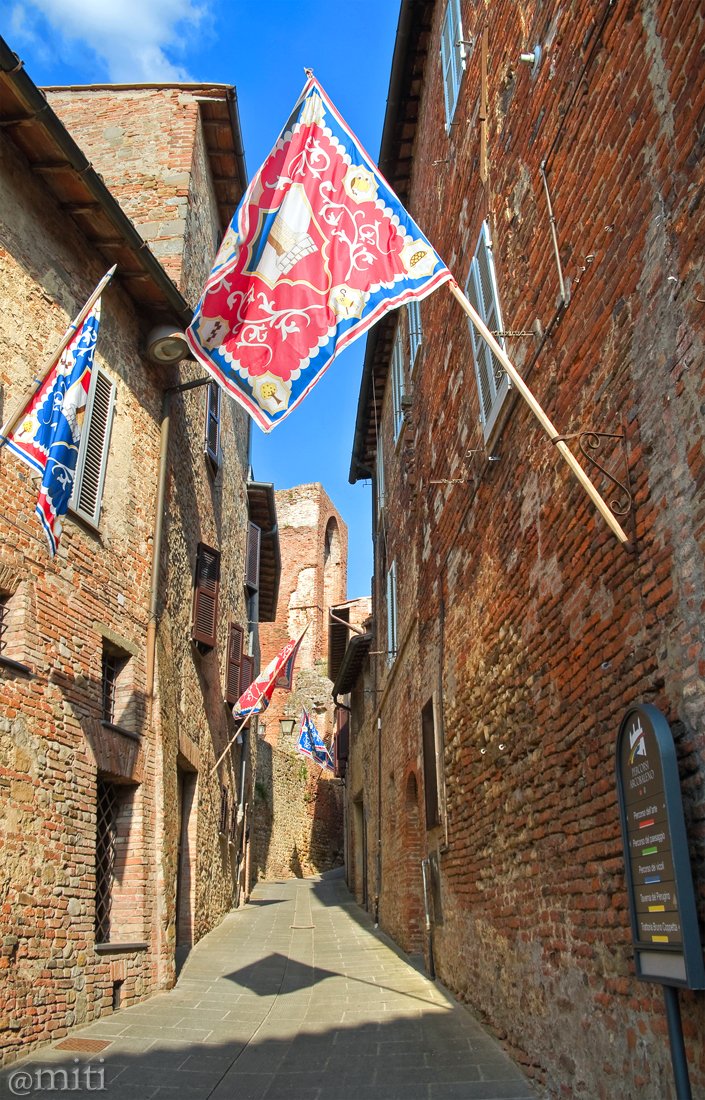
Alleyway in the historical center (Author's photo - All rights reserved)
Vicolo del centro storico (Immagine dell'autore - tutti i diritti sono riservati)



Ciao a tutti,
questo è un viaggio attraverso l'Italia. Posterò una foto al giorno con una brevissima descrizione. Spero vi piaccia!

Città della Pieve è un piccolo borgo medievale in provincia di Perugia, nella regione centrale dell'Umbria. È situato in cima ad una collina sul versante orientale della Val di Chiana
La sua origine non è nota, e certamente nel corso dei secoli ha cambiato nome diverse volte (ad esempio, "Monte di Apollo" o "Pieve di San Gervasio"). Nel XV secolo fu denominata "Città di Castel della Pieve", nome che , data la sua estrema lunghezza nella pronuncia, fu cambiato immediatamente in Città della Pieve.
Centro etrusco-romano, nel VII secolo divenne il potente Castrum Plebis, sorto attorno alla Chiesa dei Santi Gervasio e Protasio. Nel 1188 passò sotto il dominio di Perugia, e sotto l'imperatore Federico II la città libera (nel 1250) cominciò ad assomigliare a ciò che vediamo oggi. Conflitti politici e militari continuarono fino al XVII secolo, quando Città della Pieve passò sotto lo Stato Pontificio e fu trasformata in un importante centro amministrativo e religioso. Rimase sotto il dominio della Chiesa (con l'eccezione degli anni napoleonici) fino al 1860.
I commerci della città furono aiutati da numerosi itinerari che la collegarono all'importante "Via Francigena" (così chiamata perché collegava l'Italia alla Francia), che si trovava ad ovest, così i mercanti della città avevano accesso alle rotte commerciali internazionali che ha attraversato tutta la Toscana per raggiungere la valle del Po.
Gli edifici principali del centro storico furono costruiti tra il XIII e il XVI secolo, usando il mattone come materiale da costruzione - Città della Pieve fu un importante centro di produzione di mattoni nel Medioevo. Il centro storico conserva ancora il tipico impianto urbano medievale su cui furono costruiti edifici rinascimentali, barocchi, rococò e neoclassici, testimonianza della vitalità artistica di questa città.
I luoghi da vedere sono la Cattedrale dei Santi Gervasio e Protasio (Duomo), che ospita opere di due grandi artisti di Città della Pieve - Il Perugino e Il Pomarancio - e l'Oratorio di Santa Maria dei Bianchi, sede della straordinaria Adorazione dei Magi de Il Perugino.
Oltre alla torre della città, costruita nel XII secolo, e alla torre vescovile, una torre di guardia costruita probabilmente nel 1326, è possibile visitare monumenti degni di nota come il Palazzo della Corgna (XVI secolo), sede della biblioteca comunale e dello spazio espositivo, Palazzo Bandini (XVI secolo) e Palazzo Baglioni, che risale al XVIII secolo e la Rocca Perugina con le sue cinque torri: costruita intorno al 1326, era una delle costruzioni più costose dell'epoca.
Fuori dalle mura cittadine si trovano la cripta e il convento con la Chiesa di San Francesco, oggi santuario della Madonna di Fatima, la Chiesa di Santa Maria dei Servi, mentre appena fuori città si trova Santa Maria degli Angeli, un eremo francescano che assomiglia ad una struttura gotica con un campanile a forma di vela.
Cosa vedere: il centro storico, la Fortezza Perugina, la Cattedrale dei Santi Gervasio e Protasio, l'Oratorio di Santa Maria dei Bianchi, la Torre Vescovile, il Palazzo della Corgna, il Palazzo Bandini, il Palazzo Baglioni, la cripta e il convento con la Chiesa di San Francesco, la Chiesa di Santa Maria dei Servi, la Chiesa di Santa Maria degli Angeli, la Chiesa di Sant'Agostino, la Chiesa di San Pietro, il Museo Civico Diocesano.

Hello everyone,
I began a Photo Journey through Italy. I will post one photo every day with a little note of explanation. I hope you like it!

Città della Pieve is a small medieval village in the province of Perugia, in the central Italian region of Umbria. It is situated at the top of a hill on the eastern side of Val di Chiana
Its origin is not know, and certainly over the centuries has changed names several times (for example, "Mount of Apollo" or "Pieve di San Gervasio") ..On XV century was named "City of Castel della Pieve" , name that, given its extreme length in pronunciation, has changed immediately in Città della Pieve.
An Etruscan-Roman centre, in the VII century it became the powerful Castrum Plebis, which arose around the Church of Santi Gervasio e Protasio. In 1188 it come under the dominion of Perugia, and under Emperor Frederick II the free town (in 1250) began to resemble what we see today. Political and military strife continued until the XVII century, when Città della Pieve came under the Papal States and was turned into an important administrative and religious centre. It remained under the dominion of the Church (with the exception of the Napoleonic years) until 1860.
The trades of the city were helped by several routes that connected it to the important "Via Francigena" (so called because it connected Italy with France), which was located to the west, so the merchants of the city had access to international trade routes that crossed the whole of Tuscany to reach the Po River Valley.
The main buildings of the Old Town were built between the 13th and 16th century, using brick as a building material - Citta della Pieve was a major production center for bricks in the Middle Ages. The historical centre still maintains the typical medieval urban layout on which Renaissance, Baroque, Rococo and Neoclassic buildings were later constructed, proof of the artistic vitality of this city.
The sights to see are the Cathedral of Santi Gervasio e Protasio (Duomo), which houses works by two great Città della Pieve artists - Il Perugino and Il Pomarancio - and the Oratory of Santa Maria dei Bianchi, home to the extraordinary Adoration of the Magi by Il Perugino.
Aside from the city tower, built in the XII century, and the Bishop's tower, a watch tower probably built in 1326, you can visit such noteworthy landmarks as Palazzo della Corgna (XVI century), home to the city library and exhibition space, Palazzo Bandini (XVI century) and Palazzo Baglioni, which dates to the XVIII century and the Rocca (Fortress) Perugina with its five towers: built around 1326, it was one of the most expensive costs of the time.
Outside the city walls are the crypt and the convent with the Church of San Francesco, now the sanctuary of the Madonna di Fatima, the Church of Santa Maria dei Servi, while just outside the city is Santa Maria degli Angeli, a Franciscan hermitage that looks like a Gothic structure with a sail-shaped bell tower.
Thing to see: the Historic center, the Fortress Perugina, the Cathedral of Santi Gervasio e Protasio, the Oratory of Santa Maria dei Bianchi, the Bishop's tower, Palazzo della Corgna, Palazzo Bandini, Palazzo Baglioni, the crypt and the convent with the Church of San Francesco, the Church of Santa Maria dei Servi, the Church of Santa Maria degli Angeli, the Church of Saint Augustine, the Church of Saint Peter, the Civic Diocesan Museum.

| Tipo di foto / Category | Paesaggio / Landscape view |
| Esposizione / Settings | 1/100 sec, ISO 200, f/9 |
| Camera | Nikon D5000 |
| Lente / Lens | Sigma 18-125mm f/3.5-5.6 DC |
| Filtro / Filter | Polarizzatore Hoya / Hoya Polarizing filter |
| Cavalletto / Tripod | Manfrotto MKC3-P01 |
| Località / Location | Città della Pieve (Perugia), Italia |
| Software | Photoshop / HDR |


The Fortress Perugina (Author's photo - All rights reserved)
La rocca Perugina (Immagine dell'autore - tutti i diritti sono riservati)
love this sunshine
that is a very nice rustic street
Congratulations, Your Post Has Been Added To The Steemit Worldmap!
Author link: http://steemitworldmap.com?author=miti
Post link: http://steemitworldmap.com?post=a-journey-through-italy-one-photo-every-day-76-citta-della-pieve-eng-ita
Want to have your post on the map too?
Love the flags, it reminds me of the Contrada’s in Siena!
Oh yes... Citta della Pieve is very near the Tuscany region.
Good photo! I really like the streets of old cities in Europe. I want to sit here and make a drawing. Thanks for the post )
You're welcome ;-)
I wish I could )))
Greetings friend miti, I loved The Fortress Perugina ... In Italy the corridors are narrow ... It reminds me of the corridors of Venice.
Medieval cities have narrow streets and irregular to defend against attacks and threats of invaders.
Oh ok, I did not know that, every day I learn something new ... Thanks. :)
old is gold,
It looks that way.
beautiful click sir ,your really professional photographer i think you love it and i love your pics
Thanks.
Yes this is older photography ..just a great beautiful country Italy..
I agree.
One day I want to go to Italy :) following bro
En imágenes como ésta se puede detallar la cultura, historia y tradición de diversos lugares. en este caso Italia.
Well done @miti! You successfully guessed the match result.
Click on the badge to view your Board of Honor.
Do you want to know your current ranking? Read this post
Do not miss the last post from @steemitboard!
Do you like the SteemitBoard World Cup Contest?
Vote for @steemitboard as a witness and get one more award!
Well done @miti! You successfully guessed the match result.
Click on the badge to view your Board of Honor.
Do you want to know your current ranking? Read this post
Do not miss the last post from @steemitboard!
Do you like the SteemitBoard World Cup Contest?
Vote for @steemitboard as a witness and get one more award!
Excellent article. I really liked it. Good luck to you and Love.